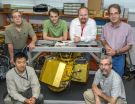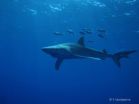(Press-News.org) AUSTIN, Texas — Researchers have determined that postmenopausal overweight or obese breast cancer patients receiving hormone therapy as part of their treatment and who use nonsteroidal anti-inflammatory drugs (NSAIDs) such as aspirin or ibuprofen have significantly lower breast cancer recurrence rates and a sizable delay in time to cancer recurrence.
The findings, published in the Aug. 14 edition of Cancer Research, suggest a new possibility for reducing the incidence of breast cancer recurrence among overweight and obese postmenopausal women, who have a comparatively higher risk of recurrence.
Using a retrospective analysis of human subjects and cell cultures, the researchers determined that NSAID use reduces the recurrence rate of the most common form of breast cancer, ERα positive breast cancer, by 50 percent and extends patients' disease-free period by more than two years. ER positive breast cancers, which grow in response to exposure to the hormone estrogen, account for about 75 percent of diagnoses.
Cancer researcher Linda deGraffenried of The University of Texas at Austin designed the study, working closely with Andrew Brenner, an oncologist from the Cancer Therapy & Research Center at The University of Texas Health Science Center at San Antonio, and Murali Beeram, a cancer specialist from the START Center for Cancer Care in San Antonio, Texas.
The investigators caution that these results are preliminary, and studies are being conducted to confirm these initial findings.
"Overweight or obese women diagnosed with breast cancer are facing a worse prognosis than normal-weight women," says deGraffenried. "We believe that obese women are facing a different disease. There are changes at the molecular level. We seek to modulate the disease promoting effects of obesity."
The investigators first examined medical records of 440 breast cancer patients, comparing the prognoses of those who took NSAIDs with those who did not.
The researchers designed a second study to examine how breast cancer cells behave in the body. By bathing ERα positive breast cancer cells in blood serum from obese women, they hoped to mimic the environment that encourages tumors to grow, proliferate and metastasize.
Although the mechanism causing breast cancer in obese women to be more aggressive and less responsive to treatment is not completely understood, the researchers believe that inflammation plays a pivotal role. Their findings also suggest inflammation negatively affects the effectiveness of aromatase inhibitors, a class of cancer drugs commonly prescribed to prevent cancer recurrence.
"Clinicians are finding that the five-year recurrence rate for postmenopausal women is much higher on aromatase inhibitors when the patient is obese," says deGraffenried. "We would like to identify which women are most likely to benefit from interventions like adding NSAIDs to treatment regimens."
Laura Bowers, who led the cell culture segment of the study, suggests that overweight or obese postmenopausal women — those at greater risk for breast cancer development — might benefit from taking a low-dose aspirin daily. "What this study does is present great promise that a fairly inexpensive and nontoxic agent might benefit obese and overweight breast cancer patients who are at a higher risk of aromatase inhibitor failure — but further studies are needed to confirm these results," says Bowers.
The research team is planning a larger prospective study to identify disease biomarkers and monitor patient response to the addition of NSAIDs to breast cancer treatment.
INFORMATION:
This study was supported by the United States Department of Defense, Breast Cancer Research Program and by the National Cancer Institute.
NSAIDs benefit overweight breast cancer patients, study finds
2014-08-14
ELSE PRESS RELEASES FROM THIS DATE:
Scientists make major breakthrough in understanding leukemia
2014-08-14
Scientists from Queen Mary University of London (QMUL) have discovered mutations in genes that lead to childhood leukaemia of the acute lymphoblastic type – the most common childhood cancer in the world.
The study was conducted amongst children with Down's syndrome – who are 20-50 times more prone to childhood leukaemias than other children – and involved analysing the DNA sequence of patients at different stages of leukaemia.
The researchers uncovered that two key genes (called RAS and JAK) can mutate to turn normal blood cells into cancer cells. However, these ...
Can our computers continue to get smaller and more powerful?
2014-08-13
From their origins in the 1940s as sequestered, room-sized machines designed for military and scientific use, computers have made a rapid march into the mainstream, radically transforming industry, commerce, entertainment and governance while shrinking to become ubiquitous handheld portals to the world.
This progress has been driven by the industry's ability to continually innovate techniques for packing increasing amounts of computational circuitry into smaller and denser microchips. But with miniature computer processors now containing millions of closely-packed transistor ...
UT Arlington team's work could lead to earlier diagnosis, treatment of mental diseases
2014-08-13
A computer science and engineering associate professor and her doctoral student graduate are using a genetic computer network inference model that eventually could predict whether a person will suffer from bipolar disorder, schizophrenia or another mental illness.
The findings are detailed in the paper "Inference of SNP-Gene Regulatory Networks by Integrating Gene Expressions and Genetic Perturbations," which was published in the June edition of Biomed Research International. The principal investigators were Jean Gao, an associate professor of computer science and engineering, ...
Three radars are better than one: Field campaign demonstrates two new instruments
2014-08-13
Putting three radars on a plane to measure rainfall may seem like overkill. But for the Integrated Precipitation and Hydrology Experiment field campaign in North Carolina recently, more definitely was better.
The three instruments, developed by the High Altitude Radar group at NASA's Goddard Space Flight Center in Greenbelt, Maryland, flew as part of the Global Precipitation Measurement (GPM) mission's six-week ground-validation program that took place May 1 through June 15 in the southern Appalachians, specifically to measure rain in difficult-to-forecast mountain regions. ...
New material could enhance fast and accurate DNA sequencing
2014-08-13
CHAMPAIGN, Ill. — Gene-based personalized medicine has many possibilities for diagnosis and targeted therapy, but one big bottleneck: the expensive and time-consuming DNA-sequencing process.
Now, researchers at the University of Illinois at Urbana-Champaign have found that nanopores in the material molybdenum disulfide (MoS2) could sequence DNA more accurately, quickly and inexpensively than anything yet available.
"One of the big areas in science is to sequence the human genome for under $1,000, the 'genome-at-home,'" said Narayana Aluru, a professor of mechanical ...
Patent examiners more likely to approve marginal inventions when pressed for time
2014-08-13
CHAMPAIGN, Ill. — Haste makes waste, as the old saying goes. And according to research from a University of Illinois expert in patent law, the same adage could be applied to the U.S. Patent and Trademark Office, where high-ranking examiners have a tendency to rubber-stamp patents of questionable merit due to time constraints.
The less time patent examiners are given to review an application, the more likely they are to grant patent protection to inventions "on the margin," says a study co-authored by Melissa Wasserman, the Richard and Anne Stockton Faculty Scholar and ...
Bones from nearly 50 ancient flying reptiles discovered
2014-08-13
Scientists discovered the bones of nearly 50 winged reptiles from a new species, Caiuajara dobruskii, that lived during the Cretaceous in southern Brazil, according to a study published August 13, 2014 in the open-access journal PLOS ONE by Paulo Manzig from Universidade do Contestado, Brazil, and colleagues.
The authors discovered the bones in a pterosaur bone bed in rocks from the Cretaceous period. They belonged to individuals ranging from young to adult, with wing spans ranging from 0.65-2.35m, allowing scientists to analyze how the bones fit into their clade, but ...
Embalming study 'rewrites' chapter in Egyptian history
2014-08-13
The origins of mummification may have started in ancient Egypt 1,500 years earlier than previously thought, according to a study published August 13, 2014 in the open-access journal PLOS ONE by Stephen Buckley from University of York and colleagues from Macquarie University and University of Oxford.
Previous evidence suggests that between ~4500 B.C. and 3100 B.C., Egyptian mummification consisted of bodies desiccating naturally through the action of the hot, dry desert sand. The early use of resins in artificial mummification has, until now, been limited to isolated occurrences ...
Little penguins forage together
2014-08-13
Most little penguins may search for food in groups, and even synchronize their movements during foraging trips, according to a study published August 13, 2014 in the open-access journal PLOS ONE by Maud Berlincourt and John Arnould from Deakin University in Australia.
Little penguins are the smallest penguin species and they live exclusively in southern Australia, New Zealand, and the Chatham Islands, but spend most of their lives at sea in search of food. Not much is known about group foraging behavior in seabirds due to the difficulty in observing their remote feeding ...
Young blue sharks use central North Atlantic nursery
2014-08-13
Blue sharks may use the central North Atlantic as a nursery prior to males and females moving through the ocean basin in distinctly different patterns, according to a study published August 13, 2014 in the open-access journal PLOS ONE by Frederic Vandeperre from University of the Azores, Portugal, and colleagues.
Shark populations typically organize by location and separate by sex and size, but these patterns remain poorly understood, particularly for exploited oceanic species such as the blue shark. The authors of this study employed a long-term electronic tagging experiment ...






